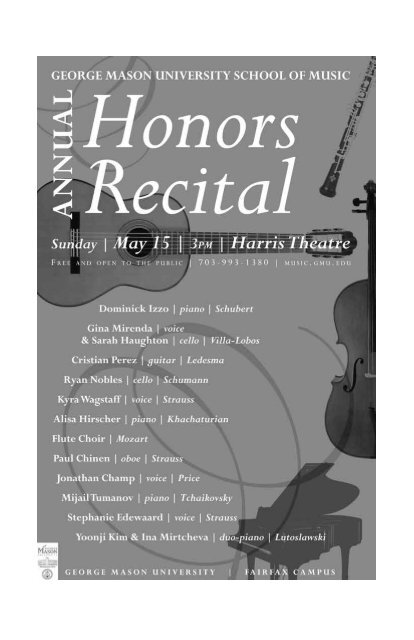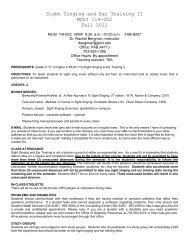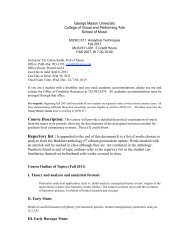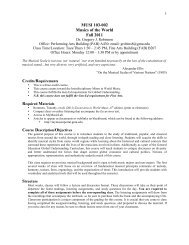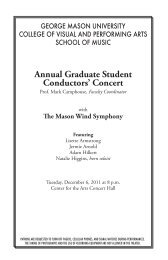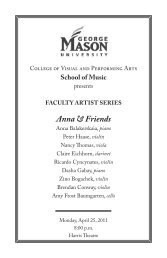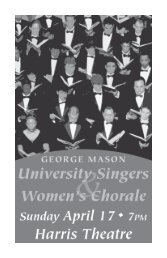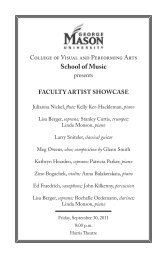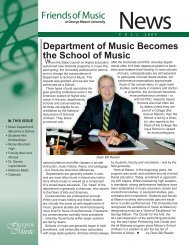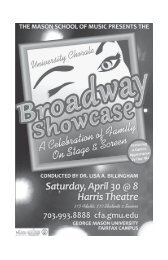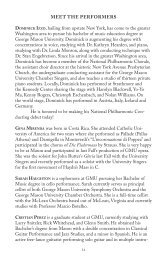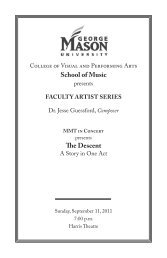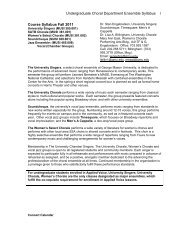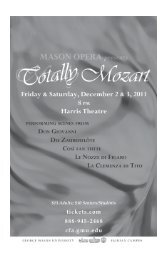complete recital program - George Mason University School of Music
complete recital program - George Mason University School of Music
complete recital program - George Mason University School of Music
Create successful ePaper yourself
Turn your PDF publications into a flip-book with our unique Google optimized e-Paper software.
The <strong>George</strong> <strong>Mason</strong> <strong>School</strong> <strong>of</strong> <strong>Music</strong><br />
presents the<br />
Annual<br />
Honors Recital<br />
Sunday, May 15, 2011<br />
3 p.m.<br />
Harris Theatre<br />
2
Program<br />
Impromptu Op. 90 No. 3 Franz Schubert (1797-1828)<br />
Dominick Izzo, piano<br />
Bachianas Brasileiras No. 5 (Aria Cantilena) Heitor Villa Villa-Lobos<br />
(1887-1959)<br />
Gina Mirenda, voice and Sarah Haughton, cello<br />
Balada del Indio Ismael Ledesma (1962-)<br />
Cristian Perez, guitar<br />
Fantasy Piece Op. 73 Robert Schumann<br />
for Cello and Piano (1st movement) (1810-1856)<br />
Ryan Nobles, cello<br />
Mein Herr Marquis Johann Strauss<br />
from Die Fledermaus (1825-1899)<br />
Kyra Wagstaff, soprano<br />
Toccata Aram Khachaturian (1903-1978)<br />
Alisa Hirscher, piano<br />
— Intermission —<br />
3
Sinfonia zu “Die Hochzeit Wolfgang Amadeus Mozart<br />
des Figaro” (1756-1791)<br />
Flute Choir<br />
Oboe Concerto in D major Richard Strauss<br />
(I. Allegro Moderato) (1864-1949)<br />
Paul Chinen, oboe<br />
Roy Hakes, piano<br />
Song to the Dark Virgin Florence Price (1888-1953)<br />
Jonathan Champ, baritone<br />
Dumka, Op. 50 Pyotr Ilyich Tchaikovsky (1840-1893)<br />
Mijail Tumanov, piano<br />
Chacun a son gout Johann Strauss<br />
from Die Fledermaus (1825-1899)<br />
Stephanie Edewaard, mezzo-soprano<br />
Variations on a theme Witold Lutoslawski<br />
<strong>of</strong> Paganini (1913-1994)<br />
Yoonji Kim and Ina Mirtcheva, duo-piano<br />
J<br />
Honors recognition Ceremony<br />
4
Program notes<br />
Franz Schubert (1797-1828)<br />
Impromptu Op. 90 No. 3<br />
Schubert was born in Himmelpfortgrund, Vienna on January 31, 1797.<br />
Even though he died at a very young age, Schubert was a prolific composer,<br />
writing nine symphonies, operas, liturgical music, some incidental<br />
music, chamber music, piano music, and some 600 Lieder (German<br />
song.)<br />
Schubert’s Impromptus, published in two sets <strong>of</strong> four, were written<br />
in 1827. The first set was published while he was living; the second<br />
was published shortly after his death in November 1828. The third<br />
Impromptu, in the key <strong>of</strong> G-flat major, is a prime example <strong>of</strong> Schubert’s<br />
incredible melodic gift.<br />
“The broad melody, above an unbroken accompaniment <strong>of</strong><br />
arpeggios, moves at a slow and steady pace. It is a perfect image<br />
<strong>of</strong> peaceful contentment. The left hand, throughout much <strong>of</strong> the<br />
piece, provides a firm harmonic support to the arpeggios and<br />
melody above, creating a rich and full sound. The middle sec<br />
tion becomes more harmonically adventurous and moves through<br />
several modulations. The bass, as well, also becomes somewhat<br />
more lively with a rising triplet motif and occasional trill.<br />
However, the repressed vigor is soon abandoned as the opening<br />
section returns, rounding out the tripartite form <strong>of</strong> the piece.”<br />
-Joseph DuBose<br />
Sources:<br />
DuBose, Joseph. “Impromptu Op. 90 No. 3 in G-flat Major, D. 899 | Peter Maxwell Land<br />
| Piano <strong>Music</strong> | Free Classical <strong>Music</strong> Online.” Classical Connect - Free Classical <strong>Music</strong><br />
Online. Web. 19 Apr. 2011.<br />
.<br />
Heitor Villa Villa-Lobos (1887-1959)<br />
Bachianas Brasileiras No. 5 (Aria Cantilena)<br />
The Bachianas Brasileiras constitute a series <strong>of</strong> nine suites by the Brazilian<br />
composer Heitor Villa Lobos. They exemplify Villa Lobos’ style, a<br />
fusion between Brazilian folk and popular music and elements from the<br />
European classical tradition. The Bachianas are viewed as an attempt to<br />
5
freely adapt a number <strong>of</strong> Baroque harmonic and contrapuntal procedures<br />
to Brazilian music. The Bachiana Brasileira No. 5, “Aria Cantilena” was<br />
originally written for Soprano and orchestra <strong>of</strong> 8 violoncelli. He later<br />
made an arrangement for guitar and voice, and it has been arranged for<br />
numerous other kinds <strong>of</strong> instrumental ensembles. It is one <strong>of</strong> his best<br />
known pieces <strong>of</strong> music.<br />
Ismael Ledesma (1962-)<br />
Balada del Indio<br />
Ismael Ledesma is a Paraguayan harpist and composer born in 1962, currently<br />
residing in France. He has traveled around the world performing<br />
his own original compositions.<br />
“Balada del Indio” was first recorded in his album <strong>of</strong> the same<br />
title in 2000. Latin-American and contemporary elements are present.<br />
The rhythms <strong>of</strong> the main two voices and how they fit together make this<br />
piece very rhythmically driving. This particular arrangement was done by<br />
one <strong>of</strong> Cristian’s mentors: Paraguayan classical guitarist Berta Rojas.<br />
Robert Schumann (1810-1856)<br />
Fantasy Piece Op. 73 for Cello and Piano (1st movement)<br />
This work was written in 1849, one <strong>of</strong> Schumann’s most productive<br />
composing years. Schumann said this <strong>of</strong> his productivity “For some time<br />
now I’ve been very busy – it’s been my most fruitful year – it seemed as if<br />
the outer storms compelled people to turn inward.” Originally composed<br />
for clarinet and piano, Schumann also included cello and violin parts in<br />
the original composition. It was his intention that the piece could also be<br />
performed by cello or violin with piano accompaniment. Fantasy Pieces<br />
consists <strong>of</strong> a three movement “cycle <strong>of</strong> poetic miniatures” beginning with<br />
a movement marked ‘Zart und mit Ausdruck’ which means ‘tender with<br />
longing.’<br />
Sources:<br />
John Daverio and Eric Sams. “Schumann, Robert.” In Grove <strong>Music</strong> Online. Oxford <strong>Music</strong><br />
Online, http://www.oxfordmusiconline.com.mutex.gmu.edu/subscriber/article/grove/<br />
music/40704pg17 (accessed April 18, 2011).<br />
6
Johann Strauss (1825-1899)<br />
Mein Herr Marquis from Die Fledermaus<br />
Johann Strauss, II (October 25, 1825 – June 3, 1899) was an Austrian<br />
composer <strong>of</strong> over 500 waltzes, polkas, and other types <strong>of</strong> dance music,<br />
as well as ballets and operettas. Among his most notable works are the<br />
operas Die Fledermaus and Der Zigeunerbaron.<br />
Mein Herr Marquis, ein Mann wie Sie My lord, marquis, a man like you<br />
Solt’ besser das versteh’n! should understand this better!<br />
Darum rate ich, Therefore I advise you<br />
Ja genauer sich die Leute anzuseh’n! to look at people more closely<br />
Die Hand ist doch wohl gar zu fein, ah, My hand is indeed much too delicate,<br />
Die Füßchen so zierlich und klein, ah this little foot so graceful and tiny, ah<br />
Die sprache, die ich führe, The language that I speak,<br />
Die Taille, die Tournüre, my waistline, my shape-<br />
Dergleichen finden Sie bei ener Z<strong>of</strong>e nie! The likes <strong>of</strong> which you’ll never find in<br />
a chambermaid<br />
Gestehen müssen Sie fürwahr You must truly admit:<br />
Sehr komisch dieser Irrtum war this mistake was truly funny<br />
Ja, sehr komisch, ha ha ha Yes, very funny, ha ha ha<br />
Ist die Sache, ha ha ha! is the thing, ha ha ha!<br />
Drum verzeih’n Sie, ha ha ha, Therefore forgive me, ha ha ha<br />
Wenn ich lache, ha ha ha…! if I laugh, ha ha ha…!<br />
Ach, sehr komisch, Herr Marquis, sind Sie Oh, very funny, lord marquis, you are!<br />
Mis dem Pr<strong>of</strong>il im griech’ schen Stil With a pr<strong>of</strong>ile in the Grecian style<br />
Beschenkte mich Natur nature has endowed me<br />
Wenn nicht dies Gesicht If this face doesn’t<br />
Schon genügend spricht, already say enough,<br />
So seh’n Sie die Figure! Then observe my figure!<br />
Schau’n durch die Lorgnette Sie dann, ah Just gaze through your lorgnette, ah<br />
Sich diese Toilette nur an, ah at this party dress, ah<br />
Mir scheinet wohl, die Liebe It certainly seems to me that love<br />
Macht Ihre Augen trübe; is making your eyes blurry;<br />
Der schönen Z<strong>of</strong>e Bild the image <strong>of</strong> a pretty chambermaid<br />
Hat ganz Ihr Herz erfüllt! Has <strong>complete</strong>ly filled your heart<br />
Nun sehen Sie sie überall; Now you see her everwhere;<br />
Sehr komisch ist fürwahr der Fall very funny, indeed, is the situation<br />
7
Aram Khachaturian (1903-1978)<br />
Toccata<br />
Aram Khachaturian was an Armenian composer and performer. He<br />
began his musical studies with the cello as a nineteen-year old, then later<br />
attended the Moscow National Conservatory where he learned from Sergei<br />
Prok<strong>of</strong>iev for a short time. He composed Toccata in 1932 as the first<br />
<strong>of</strong> three pieces in his Suite for piano. The word toccata in Italian means,<br />
“to touch.” Springing from this definition, a toccata is a fast, fingery, <strong>of</strong>ten<br />
chordal, virtuosic piece. This toccata thrives on a driving pulse and big<br />
chords, but not without a contrasting, slower, melodious middle section.<br />
Khachaturian composed a variety <strong>of</strong> music from symphonies and ballet<br />
music to piano solos and vocal works. His style generally gleans from folk<br />
tunes and dances, with strong rhythms and timbre.<br />
Sources:<br />
Virtual Museum <strong>of</strong> Aram Khachaturian. 14 April 2011.<br />
.<br />
“Aram Khachaturian.” Classical Net 2011. 14 April 2011.<br />
.<br />
“Toccata.” Encyclopedia Britannica 2011. 14 April 2011.<br />
.<br />
Wolfgang Amadeus Mozart (1756-1791)<br />
Sinfonia zu “Die Hochzeit des Figaro”<br />
Shortly after the successful first performance <strong>of</strong> Mozart’s comic opera The<br />
Marriage <strong>of</strong> Figaro, publishers brought out a number <strong>of</strong> arrangements <strong>of</strong><br />
the entire work as well as <strong>of</strong> various pieces from within it for a variety <strong>of</strong><br />
instrumental combinations. Howard Cohen’s arrangement <strong>of</strong> Mozart’s<br />
Sinfonia for four flutes actively integrates each <strong>of</strong> the parts into the musical<br />
texture and gives each flutist the opportunity to discover one <strong>of</strong> the<br />
most famous works <strong>of</strong> Viennese Classicism.<br />
Richard Strauss (1864-1949)<br />
Oboe Concerto in D major, (mvt. I. Allegro Moderato)<br />
The following personal account was shared with GMU oboist Mr. Paul Chinen<br />
by MSG Robert Huffman (an oboist for 32 years with The United States Army<br />
Band “Pershing’s Own”).<br />
8
Huffman maintained a close pr<strong>of</strong>essional relationship with oboist,<br />
John de Lancie. This included collaborations on this concerto with<br />
“Pershing’s Own” in the years before Mr. de Lancie’s passing. The Strauss<br />
oboe concerto is unique among compositions in that the story behind<br />
it can be directly traced. This story is even more remarkable when one<br />
learns <strong>of</strong> the amazing coincidences that led up to its creation.<br />
In the mid 1930s, a young oboist (age 15) was accepted into the<br />
prestigious Curtis Institute <strong>of</strong> <strong>Music</strong> in Philadelphia. He would study<br />
with the legendary oboist Marcel Tabuteau. Graduating at age 18, John de<br />
Lancie was named principal oboist <strong>of</strong> the Pittsburgh Symphony (under<br />
the renowned Strauss expert, Fritz Reiner). As World War II began, de<br />
Lancie enlisted in the United States Army Band (now, Pershing’s Own)<br />
in Washington DC. The Army Band was deployed to North Africa and<br />
spent nine months in Algiers (a French speaking colony). This <strong>of</strong>fered de<br />
Lancie an opportunity to learn French fluently. When the band deployed<br />
to the United Kingdom, de Lancie was asked to join the OSS (a precursor<br />
to the CIA). The OSS was urgently seeking Americans who spoke French.<br />
Shipped <strong>of</strong>f to France, de Lancie used his French to expose spies<br />
radio-ing American troop movements back to Germany. At the conclusion<br />
<strong>of</strong> the war he was sent to Germany himself to search for the handlers<br />
<strong>of</strong> those French spies. It was in Garmisch-Partenkirschen that de<br />
Lancie ran into his old friend from The Curtis Institute, Alfred Mann.<br />
Since, Reiner had communicated such an appreciation for Strauss, de<br />
Lancie was excited by the possibility <strong>of</strong> meeting Strauss in person. To this<br />
Alfred replied that the Strauss villa was just up the street. Alfred and de<br />
Lancie spent three days with Strauss. Strauss spoke French quite well, so<br />
they all had no trouble communicating.<br />
At one point, de Lancie asked Strauss if he had ever considered<br />
writing an oboe concerto (since he seemed to have a special affinity for<br />
the oboe, writing such beautiful oboe solos in Don Juan and Death and<br />
Transfiguration). Strauss replied simply: “no”, and was the end <strong>of</strong> the matter,<br />
or so it seemed. It was the end <strong>of</strong> WW II, and even though Strauss’<br />
association with the Nazi party had been nominal (at most) he still had<br />
to be cleared <strong>of</strong> enemy suspicion. Waiting around his villa – he decided<br />
to use this otherwise idle time to put pen to paper, one month later, the<br />
Strauss Oboe Concerto was finished.<br />
9
Soon after, de Lancie received a clipping from Stars and Stripes<br />
(a compilation <strong>of</strong> American news articles to keep the troops informed)<br />
sent to him by his brother stationed in the Pacific. The article stated that<br />
the great German composed Richard Strauss had just finished an oboe<br />
concerto inspired by a young American soldier. (This was inscribed on<br />
the original manuscript, although other sorts <strong>of</strong> personalized inscriptions<br />
appear on various editions). You can imagine the overwhelming surprise<br />
this must have been.<br />
Strauss later got in touch with de Lancie and <strong>of</strong>fered him the<br />
American premier <strong>of</strong> the concerto. By this point, de Lancie was assistant<br />
principal oboist in the Philadelphia Orchestra. The orchestra management<br />
was very excited about the idea. However, the principal oboist,<br />
Marcel Tabuteau, let it be known in no uncertain terms that if there was<br />
to be an oboe soloist, it would be him – and none other! Thus the mantel<br />
<strong>of</strong> the American premier passed to de Lancie’s friend in New York<br />
– Mitch Miller – a jazz oriented player, record producer, and the future<br />
host <strong>of</strong> the TV show – Sing Along With Mitch.<br />
-Robert Huffman, April 18, 2011<br />
Florence Price (1888-1953)<br />
Song to the Dark Virgin<br />
Langston Hughes (1902-1967) Florence Price (1888-1953)<br />
Florence Price (née Smith) was born in Little Rock, Arkansas on April 9,<br />
1888. Her father was a dentist and her mother was a piano teacher, who<br />
served as Price’s instructor. In 1903, Price continued her studies at the<br />
New England Conservatory <strong>of</strong> <strong>Music</strong> with a major in organ and piano<br />
instruction. After graduating in 1907, Price taught at a couple <strong>of</strong> colleges<br />
before becoming head <strong>of</strong> the music department at Clark <strong>University</strong><br />
in 1912. Price has composed more than 300 compositions throughout<br />
her lifetime, ranging from vocal compositions to symphonies and concertos.<br />
On June 15, 1933, the Chicago Symphony Orchestra performed<br />
her Symphony in E minor. She became the first African-American<br />
female composer to have a symphonic composition performed by a major<br />
American symphony orchestra. “Song to the Dark Virgin” is one <strong>of</strong> her<br />
most popular vocal compositions.<br />
10
Pyotr Ilyich Tchaikovsky (1840-1893)<br />
Dumka, Op. 50<br />
A form <strong>of</strong> Polish or Ukrainian ballad, a dumka is characterized by a<br />
predominantly sad or plaintive tone contrasted with a central celebratory<br />
section. Given the biographical events leading up to its composition, it is<br />
difficult not to hear the composer’s personal narrative in this music. The<br />
opening chords establish an immediate mood <strong>of</strong> intense melancholy and<br />
solitude. A pleading repeated pattern leads into the central “con anima”<br />
section and its dance-like folkloric exuberance. But the darkness <strong>of</strong> the<br />
opening is not dispelled, and a desolate resignation closes in, concluding<br />
the emotional journey more sadly than it began. Tchaikovsky wrote, again<br />
to von Meck:<br />
“You want to know my methods <strong>of</strong> composing… the<br />
circumstances under which a new work comes into<br />
the world vary considerably in each case.<br />
“(1) Works I compose on my own initiative - that is to say,<br />
from an invincible inward impulse.<br />
“(2) Works that are inspired by external circumstances: the<br />
wish <strong>of</strong> a friend, or publisher, and commissioned work.<br />
“Works belonging to the first category do not require the least<br />
effort <strong>of</strong> will. It is only necessary to obey our inward promptings, and if<br />
our material life does not crush our artistic life under its weight <strong>of</strong> depressing<br />
circumstances, the work progresses with inconceivable rapidity.<br />
Everything else is forgotten, the soul throbs with an incomprehensible<br />
and indescribable excitement, so that, almost before we can follow this<br />
swift flight <strong>of</strong> inspiration, time passes literally unreckoned and unobserved.”<br />
The Dumka is an epic on a small scale, its emotional charge no<br />
less potent than that <strong>of</strong> the Pathetique Symphony to be composed six<br />
years later.<br />
Johann Strauss (1825-1899)<br />
Chacun a son gout from Die Fledermaus<br />
Johann Strauss II was an Austrian composer <strong>of</strong> light music, particularly<br />
dance music and operettas. He composed over 500 waltzes, including The<br />
11
Blue Danube, and other dance music such as polkas, quadrilles, as well as<br />
several operettas and a ballet. He was known as “The Waltz King” and<br />
was largely responsible for the popularity <strong>of</strong> the waltz in Vienna during<br />
the 19th century.<br />
Die Fledermaus (The Bat) is a three-act operetta set in Vienna,<br />
1890s. Chacun à son goût is sung by the Prince Orl<strong>of</strong>sky who is hosting a<br />
masquerade ball at his mansion. The prince proclaims his guests free to<br />
do anything that suits their fancy — “Chacun à son goût”— as long as<br />
they please him and share his love <strong>of</strong> wine.<br />
“Chacun à son goût” Translation<br />
Ich lade gern mir Gäste ein, I like to invite guests,<br />
Man lebt bei mir recht fein, One lives quite well at my house,<br />
Man unterhält sich, wie man mag One enjoys oneself, as he likes<br />
Oft bis zum hellen Tag. Often until the light <strong>of</strong> day.<br />
Zwar langweil’ ich mich stets dabei, Although I am bored most <strong>of</strong> the<br />
time,<br />
Was man auch treibt und spricht; Whatever one says or does;<br />
Indes, was mir als Wirt steht frei, In that, what I allow myself as host,<br />
Duld’ ich bei Gästen nicht! I will not tolerate in guests!<br />
Und sehe ich, es ennuyiert And should I see anyone looking<br />
bored<br />
Sich jemand hier bei mir, Here in my home,<br />
So pack’ ich ihn ganz ungeniert, I will seize him shamelessly.<br />
Werf ’ ihn hinaus zur Tür. And throw him out the door.<br />
Und fragen Sie, ich bitte And ask me, I beg you<br />
Warum ich das denn tu’? Why then this I do?<br />
‘S ist mal bei mir so Sitte, It’s simply my custom:<br />
Chacun à son goût! Each to his own taste!<br />
Wenn ich mit andern sitz’ beim Wein When I sit with others over wine<br />
Und Flasch’ um Flasche leer’, Emptying bottle after bottle,<br />
Muss jeder mit mir durstig sein, Everyone with me must be thirsty,<br />
Sonst werde grob ich sehr. Otherwise I become crude.<br />
Und schenke Glas um Glas ich ein, And if I’m pouring glass after glass,<br />
Duld’ ich nicht Widerspruch; I tolerate no contradiction;<br />
Nicht leiden kann ich’s wenn sie schrein: I can’t stand it when they yell:<br />
12
Ich will nicht, hab’ genug! I don’t want to; I have enough!<br />
Wer mir beim Trinken nicht pariert, Anyone who doesn’t keep drinking<br />
with me<br />
Sich zieret wie ein Tropf, And refuses like a ninny,<br />
Dem werfe ich ganz ungeniert, I throw, quite unashamedly,<br />
Die Flasche an den Kopf. The bottle at his head.<br />
Und fragen Sie, ich bitte, And would you ask me please,<br />
Warum ich das denn tu’? Why I do that?<br />
‘S ist mal bei mir so Sitte, It’s simply my custom:<br />
Chacun à son goût! Each to his own taste!<br />
Witold Lutoslawski (1913-1994)<br />
Variations on a theme <strong>of</strong> Paganini<br />
Wariacje na temat Paganiniego (1941)<br />
Witold Lutoslawski was a polish composer, pianist, and conductor. He<br />
began to study the piano at the age <strong>of</strong> six and studied theory and composition<br />
with Maliszewski at Warsaw Conservatory and in Hamburg. As<br />
many other musicians, his career as a composer was interrupted with the<br />
outbreak <strong>of</strong> World War II. During the German occupation <strong>of</strong> Poland,<br />
the Germans had banned public concerts so that he worked as pianist in<br />
Warsaw cafés with another composer, Andrezj Panufnik. The duo made<br />
over two hundred arrangements, from Bach to Debussy and Ravel. Unfortunately,<br />
the only composition <strong>of</strong> his to have survived from this period<br />
is the Variations on a Theme <strong>of</strong> Paganini for two pianos (1941). 1<br />
In this piece, Lutoslawski follows the scheme <strong>of</strong> Paganini’s wellknown<br />
Caprice, but added a harmonic dimension to it. He recalled: “As<br />
a basis I took Paganini’s 24 th Caprice for solo violin and my Variations<br />
closely follow his model. In each Variation I translate the violin line for<br />
the keyboard. Polyharmony <strong>of</strong>ten occurs between the two keyboards but<br />
tonality remains a clear force with frequent traditional dominant-tonic<br />
cadences.” In 1977, he revised these variations as a Concerto for Piano<br />
and Orchestra, asked by the pianist, Felicja Blumental, who gave the first<br />
performance two years later, with the Florida Philharmonic Orchestra. 2<br />
1 “Lutoslawski, Witold,” The Oxford Dictionary <strong>of</strong> <strong>Music</strong>, 2nd ed. rev., edited by Michael<br />
Kennedy. Oxford <strong>Music</strong> Online, http://www.oxfordmusiconline.com.mutex.gmu.edu/<br />
subscriber/article/opr/t237/e6318 (accessed April 10, 2011).<br />
2 “Lutoslawski – Variaion on a Theme <strong>of</strong> Paganini for Two Pianos,” edited by Felix Aprahamian,<br />
Chester <strong>Music</strong> Online,<br />
13
meet tHe Performers<br />
Dominick izzo, a native <strong>of</strong> upstate New York, is a sophomore music education<br />
student with a double concentration in piano and voice. He studies<br />
piano with Dr. Linda Monson and voice with Dr. Kathryn Hearden.<br />
He also has had the opportunity to study conducting techniques with Dr.<br />
Stan Engebretson and serves as an undergraduate conducting assistant<br />
for the GMU Chamber Singers. Dominick serves as a leader (elected<br />
member) <strong>of</strong> the Student Advisory Council for the <strong>School</strong> <strong>of</strong> <strong>Music</strong>. In<br />
addition, he is a member <strong>of</strong> the National Philharmonic Chorale and<br />
serves as an assistant choir director at the historic New York Avenue<br />
Presbyterian Church. Dominick also teaches piano to thirteen private<br />
piano students. Dominick has performed in ensembles at the Strathmore<br />
and Kennedy Center. He also has had the opportunity to participate in<br />
ensemble performance in Austria, Italy, Iceland, and Germany.<br />
Gina mirenDa was born in Costa Rica. She attended Catholic <strong>University</strong><br />
<strong>of</strong> America for two years where she performed as Pallade (Pallas<br />
Athena) and Damigella in Monteverdi’s “L’incoronazione di Poppea” and<br />
participated in the chorus <strong>of</strong> Die Fledermaus by Strauss. She is very happy<br />
to be at <strong>Mason</strong> and participated in last Fall’s production <strong>of</strong> GMU opera.<br />
She was the soloist for John Rutter’s Gloria last Fall with the <strong>University</strong><br />
Singers and recently performed as a soloist with the <strong>University</strong> Singers<br />
for the first movement <strong>of</strong> Haydn’s Mass in C.<br />
Sarah hauGhton is a sophomore at GMU pursuing her Bachelor <strong>of</strong><br />
<strong>Music</strong> degree in cello performance. Sarah currently serves as principal<br />
cellist <strong>of</strong> both <strong>George</strong> <strong>Mason</strong> <strong>University</strong> Symphony Orchestra and the<br />
<strong>George</strong> <strong>Mason</strong> <strong>University</strong> Chamber Orchestra. She is a full-time cellist<br />
with the McLean Orchestra based out <strong>of</strong> McLean, Virginia and currently<br />
studies with Pr<strong>of</strong>essor Marcio Botelho.<br />
criStian Perez is a graduate student at GMU, currently studying with<br />
Larry Snitzler, Rick Whitehead, and Glenn Smith. He obtained his<br />
Bachelor’s degree from <strong>Mason</strong> with a double concentration in Classical<br />
Guitar Performance and Jazz Studies, and a minor in Spanish. He is an<br />
active free-lance guitarist performing solo guitar and in multiple instrumental<br />
combinations such as his Dâle Project, which will perform at the<br />
2011 Argentine Festival on May 28 th in Arlington, VA.<br />
14
yan aShley nobleS is pursuing a Masters in Cello Performance at<br />
<strong>George</strong> <strong>Mason</strong> <strong>University</strong>. She received a Bachelor’s degree in music<br />
from the <strong>University</strong> <strong>of</strong> Mary Washington. While attending the <strong>University</strong><br />
<strong>of</strong> Mary Washington (UMW) she was principal cellist in the <strong>University</strong>-Community<br />
Symphony Orchestra and Chamber Orchestra and<br />
also performed with then Mary Washington Symphony as a high school<br />
student for their Carnegie Hall performance in 2002. After graduating<br />
from UMW Ryan worked as the Executive Director <strong>of</strong> the Rappahannock<br />
Youth Symphony, private instructor, and performed with the Piedmont<br />
Symphony, Rappahannock POPS Orchestra and other ensembles<br />
in the greater Fredericksburg area before relocating to Fairfax to pursue<br />
an advanced degree in performance. Ryan currently studies cello with<br />
Marcio Botelho.<br />
kyra WaGStaff is currently a junior voice performance major at <strong>George</strong><br />
<strong>Mason</strong> <strong>University</strong> studying under Dr. Kathryn Hearden. Originally from<br />
Baytown, TX, she was a part <strong>of</strong> the Humphrey <strong>School</strong> <strong>of</strong> <strong>Music</strong>al Theatre<br />
with Theatre Under the Stars in Houston from 2001-2007, having performed<br />
in the Mainstage productions <strong>of</strong> The Wizard <strong>of</strong> Oz and Singin’<br />
in the Rain as well as been a featured cast member in the premier <strong>of</strong> The<br />
Stephen Schwartz Project. In addition to this, she also participated in<br />
Baytown Little Theatre’s production <strong>of</strong> Chicago, where she played Roxie<br />
Hart. While at GMU, Kyra has been involved in such opera productions<br />
as Gallantry (Po<strong>of</strong> Girl), Amahl and the Night Visitors, Suor Angelica (Suor<br />
Infermiera), and A Tribute to the <strong>Music</strong> <strong>of</strong> Rodgers and Hammerstein and<br />
Andrew Lloyd Webber (soloist). Over the past 3 years, she has been actively<br />
involved with summer voice <strong>program</strong>s, including New York Opera Studio<br />
with Nico Castel where she portrayed Frasquita in “The Card Scene”<br />
from Bizet’s Carmen, Spoleto Vocal Arts Symposia with Enza Ferrari,<br />
and, most recently, the V.O.I.C.Experience in Tampa, Florida with Sherrill<br />
Milnes, David Friedman, and Susan Yankee.<br />
aliSa hirScher is a freshman piano performance major studying with<br />
Dr. Linda Monson. Alisa is from Woodbridge, Virginia and is in the<br />
Honors College at <strong>Mason</strong>. She has played piano since second grade and<br />
has been home schooled. She had the opportunity to perform as keyboardist<br />
with the GMU Chamber Orchestra and Opera in Amahl and the<br />
15
Night Visitors. She is serving as an accompanist for the children’s choirs at<br />
Springfield United Methodist Church and she also teaches piano lessons.<br />
Alisa recently performed as solo pianist in the Fairfax Spotlight on the<br />
Arts Mayor’s Ball in the gala opening <strong>of</strong> the new Sherwood Community<br />
Arts Center. She is the grateful recipient <strong>of</strong> the Spotlight on the Arts<br />
Ruth Haycock Piano Award.<br />
PulSe is <strong>George</strong> <strong>Mason</strong> <strong>University</strong>’s resident flute choir. It is comprised<br />
<strong>of</strong> music performance and education majors, bachelor <strong>of</strong> arts students,<br />
and non-music majors. Formerly known as Champagne Flutes, Pulse was<br />
established in September <strong>of</strong> 2009 under the direction <strong>of</strong> Judith Lapple.<br />
The group continues today under the direction <strong>of</strong> Jennifer Lapple. Their<br />
mission is musical outreach through performance and education.<br />
Pulse Flute Choir<br />
Carly Alba<br />
Sarah Angel<br />
Conor Cafferty<br />
Kate Freeburn<br />
Sara van der Horst<br />
Courtney Kerby<br />
Grace Lane<br />
Yvonne LeFrancois<br />
Kim Miller<br />
Paul chinen is a freshman undergraduate student at <strong>George</strong> <strong>Mason</strong><br />
<strong>University</strong>. He currently studies oboe under Dr. Lorrie Berkshire-Brown.<br />
In the Fall <strong>of</strong> 2010 he was selected as a Howarth Young Artist to participate<br />
in a master-class at Pepperdine <strong>University</strong> in California. Paul has also<br />
played with the American Festival Orchestra and is Principal Oboe <strong>of</strong> the<br />
<strong>George</strong> <strong>Mason</strong> <strong>University</strong> Wind Symphony and Symphony Orchestra.<br />
Originally from Honolulu, Hawaii, Paul has performed with the Honolulu<br />
Civic Orchestra as well as the Honolulu State Pops Orchestra. He attended<br />
the Interlochen Summer <strong>Music</strong> institute in the year 2009 and has<br />
studied Oboe under Mrs. Susan Ochi-Onishi, and Linda Strommen. Paul<br />
is also an avid Saxophonist and currently studies with Mr. Rick Parrell.<br />
16<br />
Andrea Murano<br />
Caitlin Oliver<br />
Sally O’Neill<br />
Katie Rehm<br />
Agnes Rhee<br />
Jessica Salas<br />
Sarah Shapiro<br />
Amy Tanna<br />
Meghan Walsh
Jonathan rayniDo chamP is a 19-year-old sophomore at <strong>George</strong> <strong>Mason</strong><br />
<strong>University</strong>. Jonathan went to high school at the Governor’s <strong>School</strong><br />
for the Performing Arts where he developed his passion for opera/classical<br />
music. While at the Governor’s <strong>School</strong>, he was a Virginia Opera<br />
S.T.A.R. (Student Training Artistic Residency) Intern where he performed<br />
as a member <strong>of</strong> the chorus in their 100 th production <strong>of</strong> Verdi’s Il<br />
Trovatore. Since his enrollment at GMU, he has been a two time winner<br />
at the Virginia NATS (National Association <strong>of</strong> Teacher’s <strong>of</strong> Singing)<br />
competition as well as an active member <strong>of</strong> GMU Opera performing<br />
roles like The Page (Amahl and the Night Visitors), Alcindoro (La Boheme),<br />
and most recently Marco and Ser Amantio di Nicolao (Gianni Schicchi).<br />
This past summer, Jonathan made his international debut in Vietri sul<br />
Mare, Italy performing the role <strong>of</strong> Monostatos (Die Zauberflote) in the<br />
Amalfi <strong>Music</strong> Festival, under the baton <strong>of</strong> Maestro Joseph Walsh. Jonathan<br />
is a student <strong>of</strong> Patricia Miller and Samuel Bonds.<br />
miJail tumanov was born in Ukraine in 1988. In 1994, he moved to-<br />
Costa Rica, where he started his musical education at the age <strong>of</strong> 8, with<br />
Alexandr Sklioutovsky. In 1998, he was accepted into the Intensive Precollege<br />
Piano Training <strong>program</strong> at the National <strong>University</strong> <strong>of</strong> Costa Rica,<br />
as well as its sister school, the Instituto Superior de Artes, where he also<br />
studied with Ludmila Melzer. Tumanov won the Young Soloists competition<br />
<strong>of</strong> the National Symphony Orchestra <strong>of</strong> Costa Rica. Mijail has<br />
also performed with the National Symphony Orchestra <strong>of</strong> Ukraine, the<br />
Youth Symphony Orchestra <strong>of</strong> Costa Rica and the Ball State Symphony<br />
Orchestra. In 2001, he won the 5th Pinault International Competition<br />
in New York. Tumanov finished the B.M. in piano performance and<br />
pedagogy at the National <strong>University</strong> <strong>of</strong> Costa Rica in 2005 and the following<br />
year, began working towards his M.M. in piano performance at<br />
Ball State <strong>University</strong> in Indiana, under Ray Kilburn. After finishing his<br />
M.M. degree, he remained at Ball State, in the Artist Diploma <strong>program</strong>.<br />
In 2009, Tumanov advanced to the Division Round <strong>of</strong> the <strong>Music</strong> Teachers<br />
National Association Competition where he represented Indiana and<br />
was chosen as the Alternate Winner. Currently, Tumanov is working on<br />
his D.M.A. in Piano Performance at <strong>George</strong> <strong>Mason</strong> <strong>University</strong>, studying<br />
with Dr. Anna Balakerskaia.<br />
17
StePhanie renée eDeWaarD, Mezzo-Soprano, is a senior in the Vocal<br />
Studio <strong>of</strong> <strong>University</strong> Pr<strong>of</strong>essor Patricia Miller, Director <strong>of</strong> Vocal Studies.<br />
Ms. Edewaard has performed the roles <strong>of</strong> “Cherubino” in Le Nozze di Figaro<br />
and “Second Lady” in Die Zauberflöte at the 2009 and 2010 Amalfi<br />
Coast <strong>Music</strong> Festivals in Vietri sul Mare, Italy. Recently with the <strong>George</strong><br />
<strong>Mason</strong> Opera, she appeared as “La Ciesca” in Gianni Schicchi and “Hansel”<br />
in Humperdinck’s Hansel and Gretel. Ms. Edewaard has also sung<br />
supporting and leading roles in GMU productions <strong>of</strong> Street Scene (Nursemaid),<br />
Gallantry (The Announcer), Suor Angelica (The Monitor), and La<br />
Boheme (Mother). She has performed in various opera scenes including<br />
those from Così fan Tutte, The Mikado, Candide, Lakme, Die Fledermaus,<br />
Carmen, and Le Nozze di Figaro for galas at <strong>George</strong> <strong>Mason</strong> and at the<br />
Amalfi Coast <strong>Music</strong> Festival.<br />
In March 2011, Ms. Edewaard won First Place at the Virginia<br />
State NATS (National Association <strong>of</strong> Teachers <strong>of</strong> Singing) Vocal Competition,<br />
continuing on to win Third Place in the Mid-Atlantic Regional<br />
NATS Competition. Ms. Edewaard was a winner in both the 2009 and<br />
2010 Virginia State NATS, advancing both times to the Regional NATS.<br />
More recently, Ms. Edewaard received Third Place in the 2011 Friday<br />
Morning <strong>Music</strong> Club Sue Goetz Ross Memorial Student Voice Competition.<br />
yoonJi kim, a student <strong>of</strong> Dr. Linda Apple Monson, is currently a doctoral<br />
student in music at <strong>George</strong> <strong>Mason</strong> <strong>University</strong>. She graduated from<br />
<strong>Mason</strong> in 2005 with a Bachelor <strong>of</strong> <strong>Music</strong> in Piano Performance and<br />
again in 2007 with a Master <strong>of</strong> <strong>Music</strong> in Piano Performance. Yoonji has<br />
been chosen to perform in GMU’s annual Jean Carrington Cook Piano<br />
Scholarship Concerts, and was featured in the All-Steinway <strong>School</strong><br />
Piano Dedication Concert at GMU. She was also chosen to perform<br />
in the 2009, 2007, and 2004 GMU Honors Recitals. Additionally, she<br />
performed the Grieg Piano Concerto and Chopin’s Concerto No. 1 in E<br />
minor several years ago with the GMU Symphony Orchestra as a result<br />
<strong>of</strong> winning the annual concerto competitions. She has performed in<br />
Fairfax Old Town Hall for Spotlight on the Arts Scholarship Concerts<br />
and the 2009 and 2010 ARTS by <strong>George</strong>! gala. Yoonji has performed in<br />
piano master classes with Awadagin Pratt, Lise Keiter-Brotzman, and<br />
Jeffrey Siegel. She is a previous and current Friends <strong>of</strong> <strong>Music</strong> Scholarship<br />
Recipient. Yoonji teaches keyboard skills at <strong>Mason</strong> to freshmen and<br />
sophomore students. She serves as accompanist for Kwon-Sa Ensemble<br />
<strong>of</strong> Korean Central Presbyterian Church in Centreville, VA.<br />
18
ina mirtcheva started playing the piano when she was five years old<br />
and attended L. Pipkov <strong>Music</strong> <strong>School</strong> in S<strong>of</strong>ia, Bulgaria. In 1998 she<br />
moved with her family to the United States and continued her studies<br />
with Dr. Anna Balakerskaia first at Levine <strong>School</strong> <strong>of</strong> <strong>Music</strong> and then at<br />
<strong>George</strong> <strong>Mason</strong> <strong>University</strong> where she earned her Bachelors and Masters<br />
<strong>of</strong> <strong>Music</strong> in Piano Performance. She earned a second Masters in Instrumental<br />
Collaborative Piano at the <strong>University</strong> <strong>of</strong> Cincinnati College-<br />
Conservatory <strong>of</strong> <strong>Music</strong>, where she had a full graduate scholarship and assistantship<br />
and studied piano and chamber music with James Tocco and<br />
Sandra Rivers. Currently, Ina Mirtcheva is back at <strong>George</strong> <strong>Mason</strong> in the<br />
D.M.A. <strong>program</strong> and teaches Keyboard Skills classes. Ms. Mirtcheva has<br />
performed in numerous <strong>recital</strong>s around the USA and abroad as a soloist<br />
and with chamber music ensembles including at venues such as the Kennedy<br />
Center, Smithsonian Institute and in <strong>recital</strong> halls in Italy, Holland,<br />
Poland, Bulgaria and Canada. She is a winner <strong>of</strong> Schlern International<br />
Competition, VMTA and GMU Concerto Competition. She is also a<br />
recipient <strong>of</strong> a Strathmore Hall Award, J. C. Cook Scholarship, Peterson<br />
Award.<br />
Honors reCognition<br />
to outstanding 2011 graduates:<br />
anDrea lively (BA <strong>Music</strong>; BS Economics) While a student at the<br />
<strong>George</strong> <strong>Mason</strong> <strong>University</strong> <strong>School</strong> <strong>of</strong> <strong>Music</strong>, Andrea participated in many<br />
ensembles, including the Symphony Orchestra, Chamber Ensembles, as<br />
well as the String Chamber Orchestra. She studied applied violin with<br />
Pr<strong>of</strong>essor Peter Haase.<br />
michelle fleiSchman (BM <strong>Music</strong> Education) During her time as<br />
a music student at <strong>George</strong> <strong>Mason</strong> <strong>University</strong>, Michelle was an active<br />
participant with the Symphony Orchestra, Various Chamber Ensembles,<br />
Chamber Orchestra, Pep Band, and String Chamber Orchestra. She<br />
studied applied violin with Pr<strong>of</strong>essor Peter Haase.<br />
aDam PhilliPS (BM <strong>Music</strong> Education; Jazz Studies and <strong>Music</strong> & Technology<br />
Minors) As a student at the <strong>George</strong> <strong>Mason</strong> <strong>University</strong> <strong>School</strong> <strong>of</strong><br />
<strong>Music</strong>, Adam student applied guitar with Pr<strong>of</strong>essor Larry Snitzler. He<br />
also performed with the Symphonic Band, Jazz Combos, Jazz Workshop,<br />
and <strong>University</strong> Chorale.<br />
19
uPcominG muSic eventS at maSon<br />
Brass ensemble Concert:<br />
Brass <strong>Music</strong> From Renaissance to Rock<br />
Tues | May 17 | 8 pm | de Laski 3001<br />
Free and Open to the Public<br />
703-993-1380 for information<br />
music.gmu.edu<br />
<strong>George</strong> <strong>Mason</strong> <strong>University</strong> <strong>School</strong> <strong>of</strong> <strong>Music</strong><br />
For more information and a <strong>complete</strong> listing <strong>of</strong> concerts and <strong>recital</strong>s,<br />
Visit the Web site at http://music.gmu.edu<br />
<strong>George</strong> <strong>Mason</strong> <strong>University</strong> is a registered All-Steinway <strong>School</strong><br />
20


